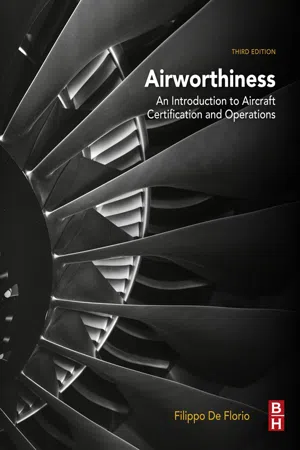
- 552 pages
- English
- ePUB (mobile friendly)
- Available on iOS & Android
About this book
Airworthiness: An Introduction to Aircraft Certification and Operations, Third Edition, once again proves to be a valuable, user-friendly reference guide for certification engineers engaged in professional training and practical work in regulatory agencies and aircraft engineering companies. The discussions reflect the recent changes in the EASA-FAA regulations and also include the concepts of flight safety and airworthiness; the ICAO and civil aviation authorities; airworthiness requirements; type certifications and the type-certification process; production of products, parts, and appliances; certifications of airworthiness; and rules for spaceworthiness.Since publication of the second edition, airworthiness regulation and certification around the world have gone through significant changes. For example, EASA structure has completely changed, FAA rules are no longer applicable, substantial changes have been made in the international airworthiness regulations and certification procedures, and unmanned aircraft have evolved technically and operationally. The changes in airworthiness regulations in the last five years have been striking, changing the way in which we look at airworthiness and certification processes around the world.- Includes updates throughout to reflect changes to the airworthiness regulations of the two most influential ruling authorities—EASA and FAA- Includes an update on remotely piloted air systems as well as space vehicles- Provides guidelines to shape a comprehensive 'certification map' including comparisons, explanations, and backgrounds of institutions and processes- Features a new chapter "Certificates of Airworthiness and Permits to Fly" that provides an overall description of the requirements governing the certificates of airworthiness
Frequently asked questions
- Essential is ideal for learners and professionals who enjoy exploring a wide range of subjects. Access the Essential Library with 800,000+ trusted titles and best-sellers across business, personal growth, and the humanities. Includes unlimited reading time and Standard Read Aloud voice.
- Complete: Perfect for advanced learners and researchers needing full, unrestricted access. Unlock 1.4M+ books across hundreds of subjects, including academic and specialized titles. The Complete Plan also includes advanced features like Premium Read Aloud and Research Assistant.
Please note we cannot support devices running on iOS 13 and Android 7 or earlier. Learn more about using the app.
Information
Flight Safety
Abstract
Keywords
1.1. Flight Safety Factors

1.1.1. The Machine
Airworthiness
Abstract
Keywords
2.1. Definition of Airworthiness
Table of contents
- Cover image
- Title page
- Table of Contents
- Copyright
- About the Author
- Preface
- Acknowledgements
- Chapter 1. Flight Safety
- Chapter 2. Airworthiness
- Chapter 3. The ICAO and the Civil Aviation Authorities
- Chapter 4. Airworthiness Requirements
- Chapter 5. Type Certification
- Chapter 6. The Type Certification Process
- Chapter 7. Production of Products, Parts, and Appliances
- Chapter 8. Certificates of Airworthiness and Permits to Fly
- Chapter 9. Air Operations Regulations
- Chapter 10. Continuing Airworthiness and Air Operator’s Certification
- Chapter 11. Airworthiness of Unmanned Aircraft Systems (UAS)
- Chapter 12. From Airworthiness to ‘Spaceworthiness’?
- List of Acronyms
- Bibliography
- Index